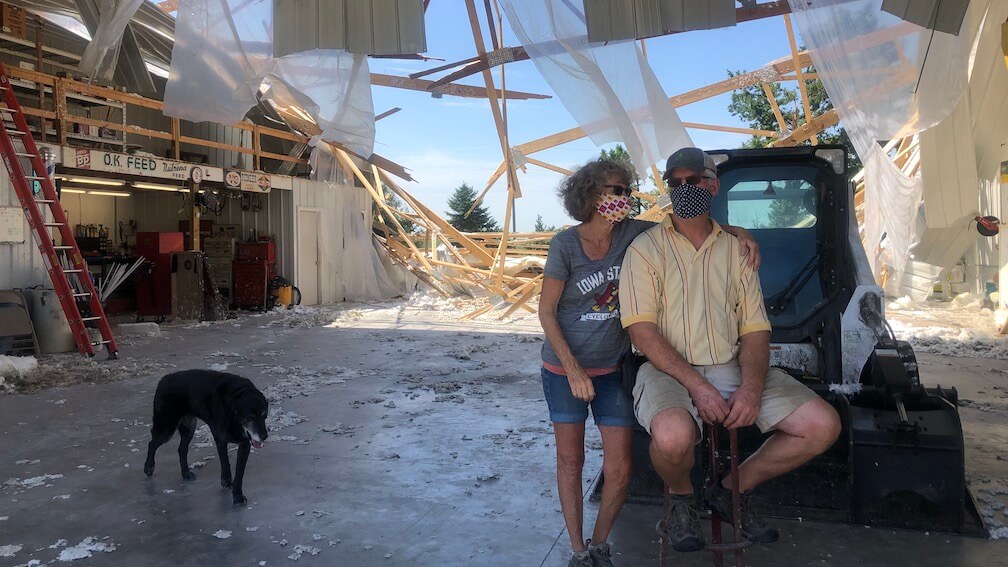
The Owens' farm in Palo
When news that a major storm was headed toward eastern Iowa last Monday, Palo farmer Gary Owens was tending to his calf-cow operation in a pasture. He received a call from his wife, Vicki, that 90-mile per hour winds were quickly approaching, so he got on his open tractor to head back to shelter.
But it was too late. The fast-developing derecho storm system likened to a category 2 hurricane brought wind gusts over 100 mph to much of central and eastern Iowa, and Gary was left outside to bear it.
With the instincts of someone who’s farmed for around 42 years, Gary said he quickly parked the tractor and took shelter in a nearby ditch.
“The rain was driving so hard that it was like shooting BBs. And so I just parked the tractor in the middle of the road and I just laid down in the ditch,” Gary said six days after the storm on Saturday, in the midst of his demolished workshop, swirling with loose insulation.
Laying for 40 minutes with his cell phone in the tractor cup holder, Gary counted the lightning as he waited.
“Did I fear for my life? Well, I knew it was a possibility. You don’t lay out there with lightning that close,” he said. “I was always told that the lightning is a mile every second. But I never even got to a thousand and one before more lightning hit. So I knew it was right on top of me.”
When Gary walked in the front door—albeit soaking wet and shivering—the family was relieved despite the storm’s additional effects, like damage amounting to “easily $1 million” after the destruction of infrastructure, crops and machinery on their family-run century farm.
“We didn’t know what vehicle he was in,” said his daughter Liz. “We just had no idea, so we were just imagining the worst. [Vicki] kept calling him over and over again and he wasn’t answering, we just didn’t know where he was and had no idea if he was dead.”
After a hot shower, he was okay enough to assess the fact that their farm, which has been in the family since 1884, was hit hard.
Currently growing corn and soybeans and alfalfa hay with a small cow calf operation and some horses for amusement, only two of 12 bins survived undamaged from the storm, while three are completely totaled along with their combine. Many of their crops are flattened or damaged while other buildings, including a massive workshop, sustained significant damage.
And the Owens are not alone. Nearly every farm in the 25 counties that the derecho struck has some damage to varying degrees. The storm impacted 37.7 million acres of farmland across the Midwest, including 14 million in Iowa, the Iowa Soybean Association said on Friday. The USDA said the storm affected 8.18 million acres of corn and 5.64 million acres of soybeans across the state.
[inline-ad id=”3″]
A Tough Harvest Ahead
Gary and Vicki are in their 60s, and have spent over 40 years making it their farm the way they want it. Now, shattered glass and nails line each pathway from crushed bin to sloped shed, perhaps with a lone wood shank or pile of bricks along the way.
Out of a gaping hole in their workshop, a ten year old space containing machinery, offices and a small historical museum, the family has a new, front-row seat to the sunset.
“Our son, he said, ‘How do you feel about 30 years of work gone over one day?’ In 40 minutes. That’s kind of what it feels like,” Gary said.
Harvest this year is going to be a nightmare, according to the Owens. The crops they can salvage will be difficult to store because of the lost or damaged bins. And they’ll need to borrow or buy a new combine. And now, all of the debris from the storm is in the fields, which poses another challenge.
“So combining is going to be a nightmare on two fronts, one: the crop is flattened, how is that going to be picked up? And the second is, when you’re driving, how do you watch for nails or debris?” said Vicki. “I usually run the combine and I am stressed about it already. How am I going to catch all of it?”
The family would have begun preparation for harvest around now, they said, with its peak in late September. While still waiting for their adjuster—who is completely overwhelmed with requests—for damage and crop insurance estimates. Gary said if they rely on crop insurance, the farm would not make as much money, but they also wouldn’t have to bear the cost of harvesting.
The storm affected 58,000 holders of crop insurance policies with a liability of around $6 billion in Iowa, according to the Iowa Soybean Association.
“It’s just a little mind-boggling to think about how we’re going to get harvest started and how it’s going to go,” said Liz. “It’s going to be very slow going.”
The family believes that they’ll at least get to harvest their soybeans, but now cleanup feels somewhat pressing.
“It really does feel urgent. You wake up every morning and you’re grateful for your life. You have your family and your house, but also when you walk out of the door it’s a little daunting,” Vicki said.
Someone who’s made the family’s bins said they’d likely get more in October, without promising anything. Some of the town elevators have told farmers they’d still take grain, but put it in a pile outside because they’ve lost their bins too. And the family also worries about cleaning everything up without help from their fellow farmers, who have their own destruction to attend to.
“Everything you see damaged here, it can be replaced. It can be rebuilt. It’s just going to take time. Because it’s such a wide area that has the same devastation, that no one can come in here and fix you, because everyone has their own problems,” Gary said. “We have to rely on people who are not from this area. We have a farmer friend that’s up by Clear Lake and he didn’t get damaged, he’s going to come and try to help. And a friend from Ankeny is coming.”
[inline-ad id=”2″]
With Damage So Widespread, Every Rural Town Fends For Itself
A 30-minute drive west, the townspeople of Van Horne spent Sunday cleaning up what was left of their storm debris with a group notably missing—the farmers.
“Normally when someone has a problem, the first people in town who help are farmers, but they all have their own problems … We had to depend on the townspeople themselves and the city equipment to get it done,” said Mayor Marty Junge as he drove a John Deere cart around the town, with a population of 656.
“The townspeople really came together. You know? Small-town Iowa is just that way. Everybody helps their neighbor and we hauled a lot of stuff in two days, and then some people had to start going back to work so we just told everybody else to pile it along the street.”
Chris Welsh, a 27-year resident of the town, agreed. She and her neighbors have worked tirelessly together to clean up their street and yards. Welsh’s garage was completely destroyed, most of her trees came down, and part of the siding on her house was stripped off.
“I’m from Cedar Rapids. 23 years ago, when I was trying to buy a house and not making a lot of money, my realtor said, I’ve got a house, but it’s about 25 miles from Cedar Rapids,” she said. “It’s the best thing I’ve ever done. I’ve raised my kids here. Just the community is unbelievable.”
They’re now running Van Horne off of a generator that’s been set up by Alliant Energy just outside town because they’re surrounded by three straight miles of down power lines. The town’s three grain bins lay dented, one with an abysmal hole which released multiple feet of grain, left piled.
“And that’s every elevator in central Iowa,” Junge said. “It’s gonna be a 5-year-deal for things to build up the way they were.”
In Wilton, Clarence and Tipton, but especially Clarence, the sound of chainsaws was constant throughout Cedar County on Friday. Trucks with beds full of tree branches and trucks were always rumbling down one street or another.
In Clarence, a town of 975 about 36 miles east of Cedar Rapids, engineer and city council member Levi VanOort heard from the county’s emergency management coordinator that Clarence was the hardest-hit community in Cedar County. No houses were completely uprooted, but some sustained significant damage, especially to garages. The local car wash was almost completely dismantled.
VanOort agreed that this storm’s damage felt different.
“The issue that we’ve really had is, if a tornado were to hit our community, what traditionally happens in that case is that the surrounding communities rally around that community and support what they need and everybody comes in,” he said. “But since this was a wide swath from basically Des Moines to Chicago, you can’t get any supplies. Generators are hard to come by, tree chippers, you can’t get trucks. And you’re really kind of fending for yourself.”
In Wilton, by Friday morning, power lines and trees mostly were cleared and the town had power.
About 57 miles southeast of Cedar Rapids, Wilton sits on the Cedar-Muscatine county border with a population of about 2,824. Derek Sawvell, the managing editor of the Wilton-Durant Advocate News, said Monday’s storm was “by far the worst” he had experienced in his 38 years in the town.
“As far as widespread damage, yes, this is by far the worst. I’ve covered a couple of tornados in my time,” he said. “I covered a few damaging storms, but more damaging to finite areas. This is, wherever you go, there’s carnage. Yes, this would be the worst I’ve seen in my career, which spans 20 years that I’ve been a journalist. And I’ve been in this area my whole life.”
[inline-ad id=”3″]
Now the communities are attempting to recover from the devastation with hopes of some state or federal reimbursement.
On Monday, President Donald Trump approved $45 million of nearly $4 billion in requested aid, part of Iowa’s disaster request for many counties. It did not include individual assistance aid, which would help farmers with their private property damage. That will likely yet get approved.
“The funny part is, we needed a rain,” Vicky said. “We hadn’t had a rain in three and a half weeks. We wanted a rain, we just didn’t want the derecho.”
by Isabella Murray and Elizabeth Meyer
Posted 8/19/20
Iowa Starting Line is an independently-owned progressive news outlet devoted to providing unique, insightful coverage on Iowa news and politics. We need reader support to continue operating — please donate here. Follow us on Twitter and Facebook for more coverage.

Big corporations are suing to block Biden’s efforts to lower costs
From the cost of medication to education to everyday expenses, the Biden administration has passed several laws and implemented many federal rules...

Iowa Republicans make outlawing gay marriage key 2024 campaign priority
Iowa Republicans have made outlawing gay marriage a key goal in their 2024 party platform. During the Iowa GOP’s 2024 state convention on Saturday,...

Department of Justice says Iowa immigration law violates US Constitution
If Iowa doesn’t suspend the enforcement of its new immigration law by May 7, the state could face a federal lawsuit, according to the Des Moines...

Rushing: Iowa State president said the quiet part out loud
I want to thank Iowa State University President Wendy Wintersteen for doing us all a favor by finally saying the quiet part out loud: all the...

Iowa sets aside almost $180 million for year two of voucher program
Iowa has committed nearly $180 million in taxpayer funds to support private school tuition in the 2024-25 school year, which is almost $50 million...

Kalbach: Immediate action needed on corporate ag pollution
Iowa agriculture has undergone substantial changes over the past 40 years. We see it all around us. Rather than crops and livestock being raised on...











